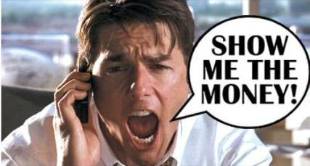“Show me the money!”
This memorably great line from the 1996 movie “Jerry Maguire” might just as well be coming from today’s CEOs and CFOs: a growing and vocal demand for accountability from the Marketing function.
 Big Data Coming – For Better or Worse
Big Data Coming – For Better or Worse
Everywhere you go these days, you hear about “big data:” the coming golden age where all problems will be solved by crunching massive amounts of data from the web and every other imaginable source. You would think that the CMO’s ability to, indeed, show them the money, would never be better.
But according to a recent IBM study, “From Stretched to Strengthening,” there is still a yawning gulf between the accountability demands of the CFO and their CMO’s ability to answer them. IBM interviewed over 1,700 CMOs, across 19 industries and 64 countries. And what did they say? CMOs said that the data explosion is one of the top four challenges they face. What was once seen as golden opportunity is becoming a huge problem as the data explosion overwhelms Marketing organizations.
Big Data ≠ Better ROI Measurement
But here’s the paradox. In the same study, almost half of the CMO’s believe that they are insufficiently prepared to provide hard return on marketing investment numbers on their key Marketing programs. Let me say that again: CMOs are being overwhelmed with data yet can’t adequately measure the ROI for their Marketing programs. How can that be?
Three Forces Transforming Advertising
Let’s take traditional advertising. It’s being transformed by three major forces: fragmentation, digitization, and social media. These forces are driving increases in data that are making it increasingly challenging to understand what works, what doesn’t, and how ROI differs across initiatives.
For example, it used to be enough to measure the effectiveness of an ad in copy testing and “know” whether you had effective advertising or not. But in today’s world, the same ad will perform differently when delivered in linear TV vs. on-line video vs. tablets vs. mobile. And, social media will impact the effectiveness of the ad and vice versa. Not to mention the interactive effects of these platforms or the fact that within a medium, ad performance will differ across TV programs, genres, and web sites.
A Simple Framework for Assessing Advertising Effectiveness
What’s a CMO to do? Simplifying this data explosion into several simple concepts can provide huge insight and opportunities for CMOs to not just measure the ROI of their advertising but to optimize it. Here are three simple concepts to help you assess advertising effectiveness.
Reach – The first job of any advertising campaign is to reach the right audience. How well is your brand doing at this? It’s amazing to me how few CMOs have any real systems in place to understand how efficiently their advertising is hitting their target—particularly in digital.
It’s now possible to measure reach, frequency, and GRP’s against a demographic target on-line just as you would in TV—on a daily basis. Early learnings show that advertisers could be saving 10-20% by simply optimizing reach against their target across sites.
Resonance – Having reached the right audience, the next job of advertising is to get noticed. Breaking through is the most important job of advertising, because if it doesn’t, nothing else matters anyway. But beyond breakthrough, advertising needs to change consumer opinions about your brand. How well is your brand doing this—right now?
The real news in the resonance space is the measurement of all this in near real time. CMOs can use these in-flight insights to improve performance in market—and not wait till the next cycle. Optimizing creative unit rotation, media weight, programming, placement and cross-platform exposure are all opportunities in the new world of optimization “on the fly.”
Reaction – Advertising exists to drive behavioral change. Usually this means increasing sales, but it can also mean getting consumers to search for your brand, go to your Facebook fan page, talk positively about your brand, etc. Measuring reaction is key to understanding if your advertising is going the final mile to cause behaviors that result in a positive ROI.
Panels which track (with consumers consent) both TV viewing and Web surfing behavior enable Marketers to measure advertising’s impact on search, etc. Market Mix Modeling and Single Source measurement (measuring what consumers watch and buy at the household level) measure sales lift and ROI by media platform and helps to answer the age old questions of how much to spend and how to allocate across which platforms.
These three concepts—reach, resonance, and reaction– provide CMOs a simple framework for thinking about advertising effectiveness and how they can optimize their advertising and media plans. In my next post, I’ll tell you more about how this actually works in practice.